The boy couldn’t have been more than seven or eight years old but he seemed perfectly at ease with the Bedouin men sipping tea in the cafe at Petra, Jordan. He tossed his unruly black curls out of his eyes, flashed a pearly smile that split his deeply tanned cheeks, and lit up a hand-rolled cigarette. Outside, two immense camels sat on their haunches under a searing sun. Every few seconds, one of them brayed in protest, exposing its blocky yellow teeth to the world. Multi-colored striped blankets were mounded between the front and rear pommels of their saddles, but no amount of cushioning could hide the fact that these ungainly beasts are a nightmare to ride.

When both camels started screaming in unison the boy jumped up from his bench and made a beeline for them. “I hope he’s careful,” I thought. Camels can be bitingly mean. My alarm turned to astonishment when he picked up the rope of the lead camel, put one foot on its flank, and swung up into the saddle effortlessly. Boy and camel rose in one fluid motion, as if they’d been born that way. The second camel grudgingly rose and the trio galumphed off in a cloud of ocher dust. I shouldn’t have been surprised. Bedouins learn to ride in the womb.

Twenty minutes later the same two camels reappeared carrying bouncing tourists holding on for dear life. I didn’t see the boy until they passed. He was hanging off the rump of the rear camel, holding on by fingertips alone. Again my jaw dropped. Sumeiman, the owner of the cafe, laughed. “He’s a crazy camel rider. He races sometimes in Amman. No saddle. Goes like hell.”
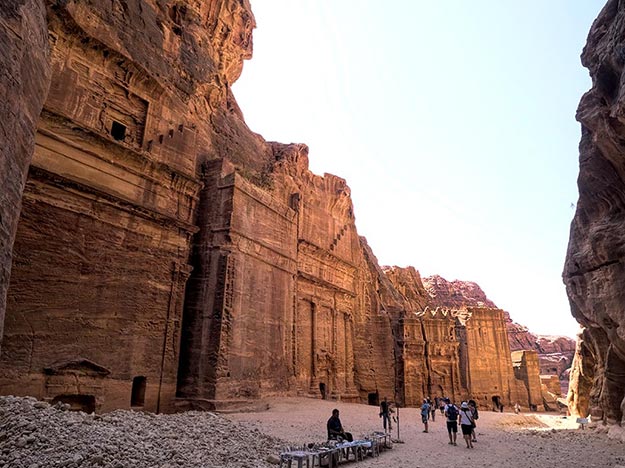
The Bedouins of Jordan were originally a nomadic people who herded goats and dromedary (single-humped) camels in the desert. Camels were especially critical to their ability to survive scorching summer temperatures that regularly exceed 110 degrees Fahrenheit. Not only were they the main source of food and means of transportation, camel races organized during wedding celebrations and religious festivals played a crucial role in the cultural traditions of Bedouin tribes.Today camel racing remains an important part of Bedouin culture. Jordan’s biggest race of the year is held during the Sheikh Zayed bin Sultan Al Nahyan Camel Race Festival. The tenth anniversary of the event was held this past November in the small village of Al Disah, located on the northeast edge of Wadi Rum. More than 500 camels competed in twelve races during the two-day festival.
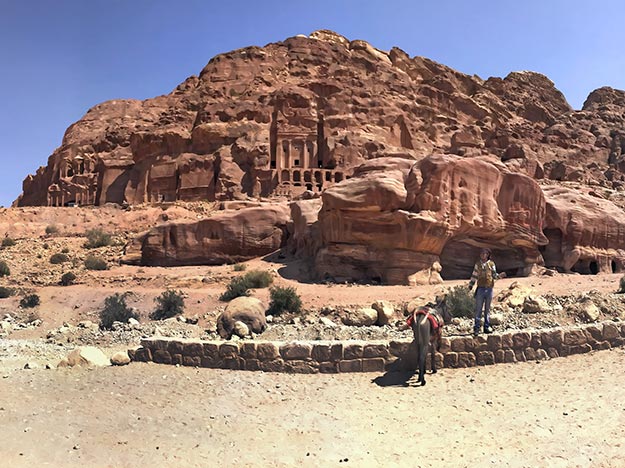
Though camels might seem an unlikely choice for a racing animal, the ungainly creatures can run at speeds up to 40 miles per hour (65 kph). To enhance their chances of winning, owners traditionally employed child jockeys, many of whom came from South Asia or Africa. Children as young as two years of age were taken from their homes by traffickers or sold into slavery by their parents. They were placed in camps near the racetracks, where they were starved in order to keep their weight down and denied education. Some rescue agencies estimate that up to 40,000 children have suffered this fate.
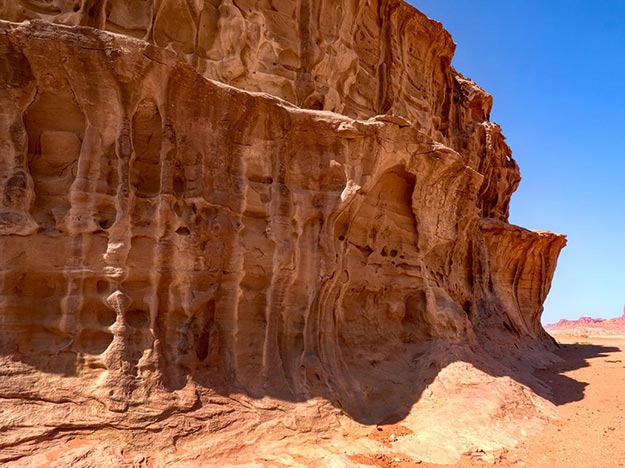
Once the extent of the problem began to emerge, countries took action. In 2005, the UAE enacted federal legislation that made it illegal to use jockeys under the age of 16. Today, the camels that race at Jordan’s Sheikh Zayed bin Sultan Al Nahyan festival are controlled by robotic radio-controlled jockeys fitted with an automatic whip. When the starting gates spring open, owners speed down sand roads alongside the track in 4WD vehicles, controlling their camels via walkie-talkie speakers. Not only is the new technology eliminating human trafficking within the industry, it has unexpectedly benefited tourism. Visitors can pay for the opportunity to ride with camel owners in their 4WD chase cars.
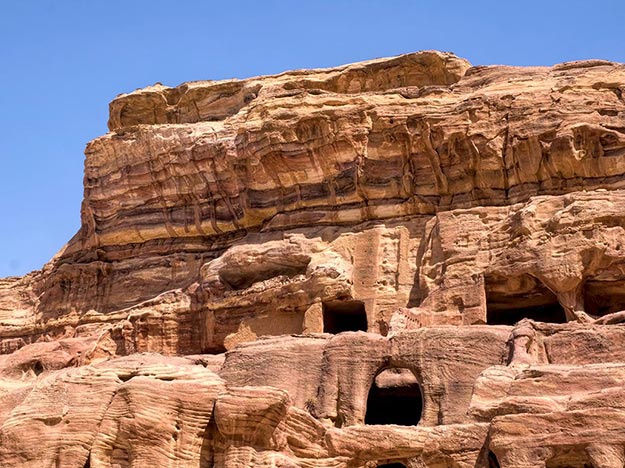
These days, the majority of the Bedouins of Jordan have settled in villages, however not all abandoned the nomadic lifestyle voluntarily. When the Lost City of Petra was awarded UNESCO World Heritage status in 1985, many Bedouins were still living in the caves that riddle the surrounding sandstone cliffs. To make Petra more palatable to tourists, the cave-dwelling Bedouins were relocated to Umm Sayhoun, a new village built by the government just over the hill from the archaeological site.

Thirty-two year old Sumeiman, owner of the cafe where I met the adolescent camel racer, was one of those who was forcibly relocated. Shortly after he was born in a cave just behind Great Palace, the family moved to the newly created town. Recently, Sumeiman moved back into a cave. “There are not enough houses for us,” he explained. “And even if there were, the houses are hot. Our caves are simple, but they’re cool in the summer and warm in the winter. More and more of us are returning.”
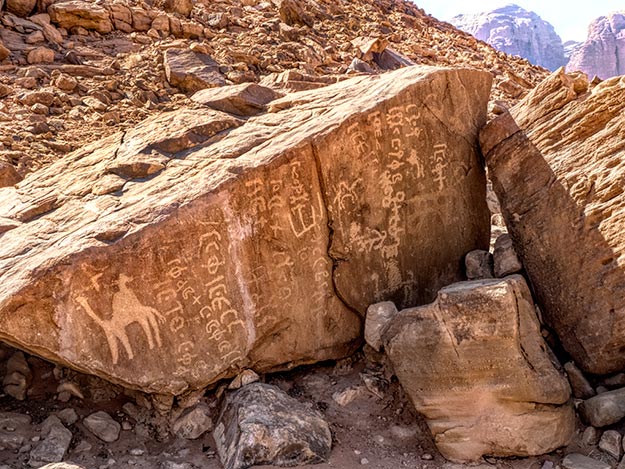
But even this solution is no panacea, according to a Bedouin shop owner who was hawking myrrh and frankincense incense. “Petra used to be very green. The wadi was full of water and the landscape was lush but years of overgrazing has turned everything to dust.” Now every drop of water for drinking, bathing, washing, and cleaning water must be hauled in on donkeys or in cars equipped to handle the harsh terrain.

Tribes who live in Wadi Rum, a region in the far south of Jordan, seem to have fared somewhat better. Here Bedouins have constructed tourist camps in the most remote corners of the desert, using methods honed over millennia. I arrived at one of these, Desert Rose Camp, on a blistering September afternoon. My traditional goat hair tent was hot to the touch outside, but the silk-draped interior was comfortably cool. I stripped down and showered off the sweat in my private ensuite bathroom, then fell backward into the big brass bed for a long nap.

It was dusk when I awoke. The searing daytime temperatures had plummeted with the setting sun, so I layered a sweater over my T-shirt and jeans and headed back out. After a delicious dinner in the outdoor pavilion, I lay back on a rock and marveled at the profound stillness. In the absence of all light, the night sky overflowed with stars. I had to force myself to go to bed.
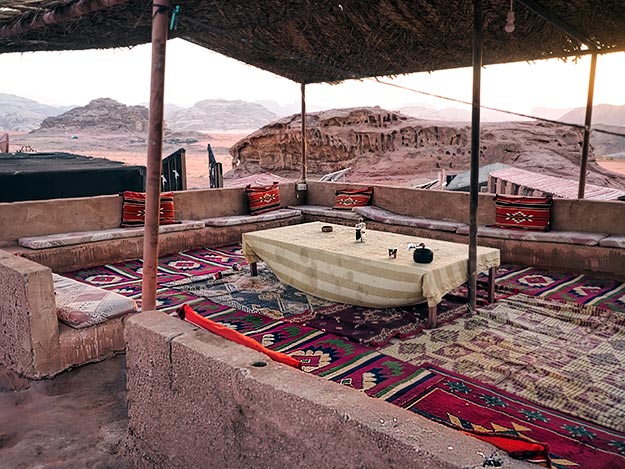
The following day offered a different kind of beauty when I climbed into a jeep for a tour of the surrounding desert. At each turn, a new canvas materialized. Monolithic rocks thrust up suddenly from the desert floor. Springs bubbled at the rear of shadowy canyons cleft into the mountains. Lush green brush carved trails through Wadi Rum’s copper-colored arroyos.
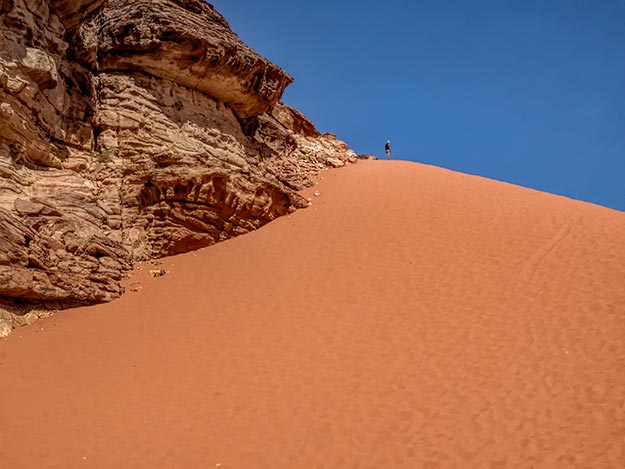
At the foot of an enormous red sand dune I sipped sweet tea with a group of young Bedouin men who spend half of each year in their village and the other half herding goats and camels. Their broad smiles and happy chatter broadcast utter contentment. In that moment, I knew that the nomadic life of the Bedouins of Jordan may be endangered, but it is far from extinct.
If you enjoyed this story, you may also to read my article about my terrifying trip into Mujib Canyon, Jordan, which also provides advice on the best way to book a private tour of Petra and Wadi Rum.

Great entry, Barbara! I have mixed feelings about this. I fell in love with the rock formation, ruins, and even camels. The sad part is the racing culture where both animals and children are being exploited.
Thanks Emily. Fortunately, there have been some positive things happening in that arena. Some countries that participate in camel racing have now outlawed the use of child jockeys, so I think the future bodes much better.
Thank you Barbara for sharing your story with amazing pictures! Glad to know the affection of camel owner for his camel. I had been to Wadi Rum 2 years ago and I too had such a wonderful experience.
Wadi Rum is truly spectacular James. Thanks for your comment.
Absolutely gorgeous. Did you feel safe traveling in Jordan?
Hi Veronica: I have to laugh at your question (you may want to go back to the blog and read my article titled “A Terrifying Trip into Mujib Canyon”). I made the mistake of reading the State Department warnings for Jordan before going, which said there had been kidnappings for ransom. So when I was driven into a remote area by my driver and met men with rifles, it gave me a bit of a scare. But they were harmless hunters and police officers. Jordan, in my estimation, is pretty darn safe, and the locals are absolutely wonderful.
So glad to hear you say nice things about the Jordanians. They sweet and generous people. I visited there 4 times before moving there for 3 years. It is my second home and I miss it like crazy. I was “adopted” by a Palestinian family which is now the only family I have. Did you visit Jerash or Ajloun? Recommended for your next Jordanian visit and Aqaba too.
Thanks Mark. I do plan to return, so I’ll check into those additional locations.
What a beautiful narration. To see first hand the relationship between man and his animal is such a privelege!
Thank you Sandeepa. I always thought camels were mean, but I even saw one Bedouin kiss his camel on the lips!
Nice written information
Thanks so much Tim.
Hi Barbara! I LOVED your post……entertaining and informative as always. I was very skeptical going to Wadi Rum, thinking of camel smelling blankets and snakes in the sand…..I am so thankful the desert camps are as comfortable as they were. We didn’t have windows, and no ensuite bathrooms….but I sure was thankful for what we had. I LOVED their food and hospitality and energy. Thanks for the great write-up!
You’re welcome Paula. So glad you enjoyed my story. Hope our paths cross again at some point.
I love reading this kind of information too much.
Glad you enjoyed it, Alice.
I have been in Wadi Rum at least ten times and it still amazes me, but why can tourists not adapt to local standards? How hard can it be to sleep on the colourful mats, or in a sleeping bag in open air and enjoy the thousand stars? People want authenticity, but also can’t let go of their comfort. If it continues like this, there will be chairs, tables, bathrooms… in the desert and the real WadiRum won’t exist anymore.
Pitty…
Hello Karin: The “real” Wadi Rum will always exist…for the Bedouins. The tourist camps were set up for tourists, with the understanding that most foreigners would prefer a little more comfort than a Bedouin. Of course, there’s nothing stopping anyone from walking into the blistering desert during the day with a sleeping bag on their back and crawling into it as the temperatures plummet once the sun goes down. But if that was the offering, I think few would accept it. And then the whole purpose would fail. The Wadi Rum camps earn money for Bedouins so they can continue their preferred way of life. Kudos to them for coming up with a way to do it that would attract the most people, while still providing a taste of their way of life.
I find it hard to believe that a traditional Bedouin tent would have a bed like the one in the picture. Looks more like glamping than camping!
Well of COURSE a traditional Bedoiun tent wouldn’t have a bed like the one in my tent. The desert camps are set up for tourists. But the tents are genuine, constructed in a traditional manner, and they allow us to experience the wonders of the deserts of Wadi Rum.